


WEEKLY WHINE
Do you remember the 1980s? Hopefully you do, since most major motion pictures produced these days are just remakes and updates of things that were popular then, like the Transformers, the Muppets, and those little blue guys who ran around stealing apples and stuff. You know, the New York Mets.
Another thing that was popular then is the Rubik’s Cube. If you are one of those people who have an unsolved cube sitting around somewhere in your home, it’s time to get it out. We’re going to solve it.
Well, actually, this week we’re not going to solve it. We’re just going to talk about some things you should know about it before you try to solve it.
 |
 |
| FRONT | BACK |
|---|
There’s your cube. Looks neat, right? But of course, your cube probably doesn’t look like that. Yours might look like this:
 |
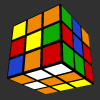 |
| FRONT | BACK |
|---|
Or maybe this:
 |
 |
| FRONT | BACK |
|---|
But it won’t look like this:
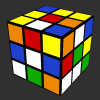 |
 |
| FRONT | BACK |
|---|
Not unless you took it apart and put it back together. But if you did take it apart and put it back together in such a way that it looked like that, you’d never be able to solve it without taking it apart again. That’s because each single move [where “move” means turning one face 90° in either direction] reorients multiple pieces – called cubies – at a time.
By the way, did you notice an important fact in the cube pictures above? Look again. The centre cubie of each face is the same colour in each of those cubes. The red is always on the top, the white is always on the front, and the yellow is always on the back. This is another important fact about the cube: The centre cubies cannot be moved relative to one another. If your cube has the same colours as the original Rubik’s Cube, the red centre cubie will always be opposite the orange, the white opposite the yellow, and the green opposite the blue. That means your cube will never look like this:
 |
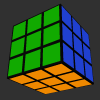 |
| FRONT | BACK |
|---|
So how do you solve the cube? Basically, you have to put all the cubies in the right place, with the right orientations. You have your six centre cubies:
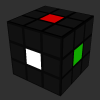 |
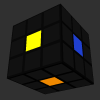 |
| FRONT | BACK |
|---|
Plus eight corner cubies:
 |
 |
| FRONT | BACK |
|---|
And twelve edge cubies:
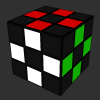 |
 |
| FRONT | BACK |
|---|
To move them around, we just turn each face ninety degrees at a time. It’s that easy.
Of course, you still have to know which faces to turn in what order. There is a fairly standard system out there wherein each face is identified by a letter: Up, Down, Left, Right, Front, and Back. A letter by itself means to turn that face clockwise 90° as you’re looking at that face:
| BEFORE | AFTER F TURN | AFTER B TURN | |||
|---|---|---|---|---|---|
 |
 |
 |
 |
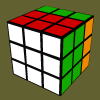 |
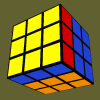 |
| FRONT | BACK | FRONT | BACK | FRONT | BACK |
A letter followed by a prime sign means to turn that face anticlockwise 90°:
| BEFORE | AFTER F' TURN | AFTER B' TURN | |||
|---|---|---|---|---|---|
 |
 |
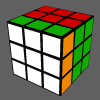 |
 |
 |
 |
| FRONT | BACK | FRONT | BACK | FRONT | BACK |
And a letter followed by a 2 means to turn that face 180°:
| BEFORE | AFTER F2 TURN | AFTER B2 TURN | |||
|---|---|---|---|---|---|
 |
 |
 |
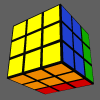 |
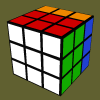 |
 |
| FRONT | BACK | FRONT | BACK | FRONT | BACK |
Then, we can describe an algorithm by giving you a letter, with a prime or 2 modifier, for each move. That means you can solve this cube with the algorithm R' D L2 D' R:
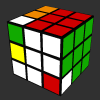 |
 |
| FRONT | BACK |
|---|
Go ahead, give it a try on your own cube. Or, if you don’t have a cube, you can use Jaap Scherphuis’s Cubie applet. You can simply use it to toy with the cube and see what happens, or you can ask it to compute the solution for an arbitrary starting point.
We’ll be back later with some methods for solving the cube, but in the meantime, you can read more about how the cube works in the theory section of Ryan Heise’s cube site.
PLEASE SEND ALL INCOHERENT RANTS TO <GOOBNET@GOOBNET.NET>
© 2018 GOOBNET ENTERPRISES, INC [WHICH DOESN’T ACTUALLY EXIST HOWEVER]
THIS FILE ACCURATE AS OF: THU 06 DEC 2018 – 06:34:54 UTC · GENERATED IN 0.005 SECONDS